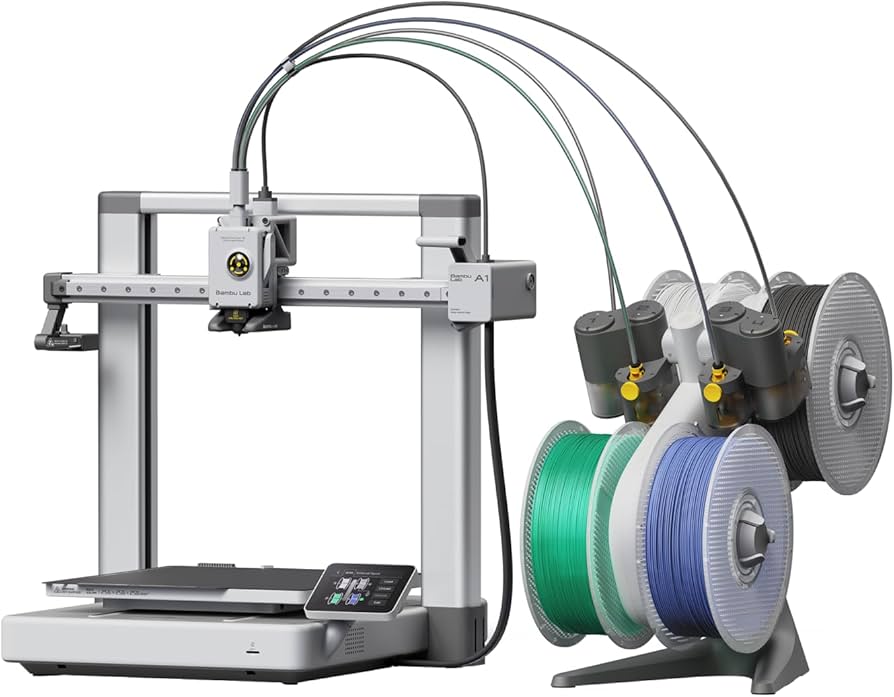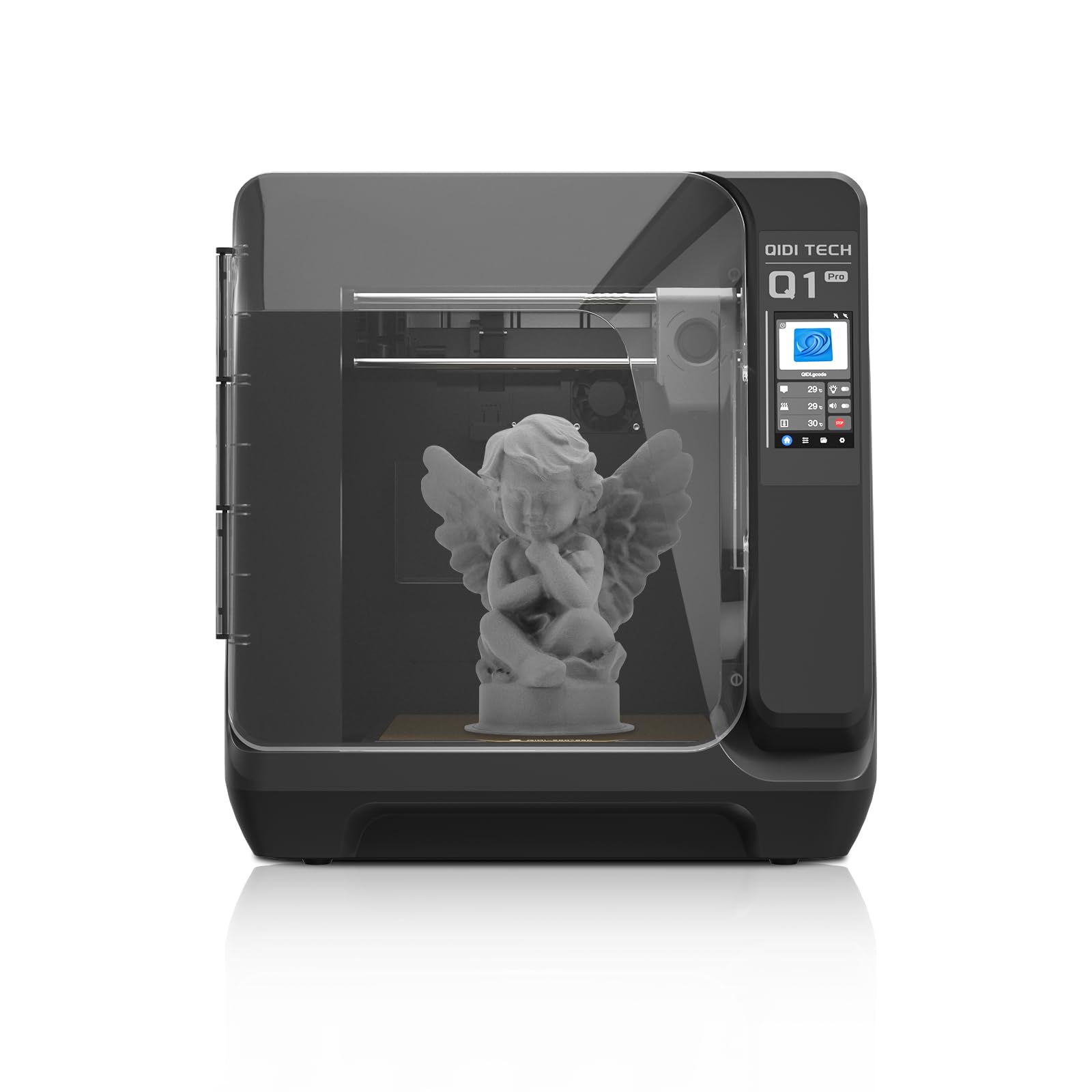Compare A1 vs Q1 PRO
Comparison between the best 3D printers
Choose the best 3D printer at the best price. The cheapest 3D printers are here.
Buy a 3D printer here with 3D Fila.
 |
 |
|
| Model | A1[BUY A1] |
Q1 PRO[BUY Q1 PRO] |
| Printing Material | Filament | Filament |
| Buy Filament for Bambu Lab A1 | Buy Filament forQIDI Q1 PRO | |
| Estimated price | $700,00 | $449,00 |
| Manufacturer | Bambu Lab | QIDI |
| Release Year | 2023 | 2024 |
| Print Volume [mm] | 256x256x256 | 245x245x245 |
| Printer Size [mm] | 385x410x430 | 467x477x489 |
| Weight [kg] | 8,3 | 20 |
| Power Loss Recovery | YES | YES |
| Enclosed printer | NO | YES |
| Bed Leveling | Automatic | Automatic |
| Filament End Sensor | YES | YES |
| Bed type | Heated | Heated |
| Power supply system | Direct Drive | Direct Drive |
| Standard nozzle | 0,4 | 0,4 |
| Maximum Nozzle Temperature [°C] | 300 | 350 |
| Maximum Bed Temperature [°C] | 100 | 120 |
| Maximum printing speed [mm/s] | 500 | 600 |
| Filament holder | YES | YES |
| Camera for supervision | YES | YES |
| Recommended filaments | PLA, PETG, TPU, PVA | PLA、ABS、ASA、PETG、TPU、PC、PA、PA-CF、PET-CF、PAHT-CF etc. |
| Recommended slicers | SuperSlicer, PrusaSlicer, Cura, OrcaSlicer | QIDI Slicer/Cura/Simplify 3D/ORCA/PRUSA Slicer |
| Maximum Resolution [mm] | 0,1 | 0,1 |
| Processor | Cortex-A53,64-bit Processor | |
| Display | Touchscreen 3,5 | Touchscreen 4,3'' |
| Power Supply | 350 W | 350 W |
| Connectivity | Wi-Fi, Bambu-Bus, Cartão Micro SD | WiFi/USB Flash Drive/Ethernet Cable |
| Operating systems | Windows, Linux, Macbook | Windows, Linux, Macbook |
| Date of registration in the system | 2024-07-17 | 2024-07-09 |
| Release date | 2023 | 2024 |
| Extra features | The BambuLab A1 printer features fully automatic calibration, multi-color printing with the AMS system, active flow rate compensation, quick nozzle change with a clip, active motor noise cancellation, a build volume of 256x256x256 mm³, a maximum extruder temperature of 300°C, and a heated bed of up to 100°C. In addition, it has high precision, a machine health management system and an intuitive 3.5-inch touchscreen interface. | The QIDI Q1 Pro 3D printer stands out for its Core XY structure and heating chambers that reach up to 60ºC, ideal for advanced materials such as ABS and Nylon. It features Klipper firmware, an automatic leveling system, a high-flow extruder with a double metal nozzle and a hotend that reaches 350ºC. It offers connectivity via Wi-Fi, USB and Ethernet, as well as a 1080p camera for remote monitoring and an intuitive touchscreen for easy operation. |
| Support for multiple colors and materials (AMS and CFS) | YES | NO |
Notes * |
||
| Cost-benefit | 7 / 10 | 8 / 10 |
| Hardware | 4.2 / 10 | 4.8 / 10 |
| Tela | . | . |
| Print volume | 4 / 10 | 3 / 10 |
| Performance | 4 / 10 | 5 / 10 |
| [BUY A1] | [BUY Q1 PRO] |
Conclusion |
| In comparing the Bambu Lab A1 and the QIDI Q1 Pro 3D printers, several key differences emerge that cater to varying user needs and preferences. The Bambu Lab A1, while being the more expensive option, offers a range of advanced features such as multi-color printing capabilities and high precision, along with impressive print speeds of up to 500 mm/s. Its design emphasizes ease of use with fully automatic calibration and a user-friendly touchscreen interface. However, it does not provide an enclosed build chamber, which might limit its effectiveness when printing with certain materials that are more temperature sensitive. On the other hand, the QIDI Q1 Pro is positioned as an excellent choice for those who require a robust printer for a variety of advanced materials such as ABS and Nylon. This model benefits from a heated chamber, allowing for better thermal management during printing, and has a higher maximum extruder temperature of 350°C. Though its printing speeds are slightly higher, it adds value with features like Ethernet connectivity and a camera for remote monitoring. However, its larger size and weight may be a consideration for users with limited space. Both printers offer automatic bed leveling and filament end sensors, and they support multiple slicers, making them versatile choices for different users. Ultimately, the decision should weigh the importance of speed and advanced features against material compatibility and design preferences. The Bambu Lab A1 is ideal for users who prioritize rapid printing and ease of use, while the QIDI Q1 Pro is suited for those who need a versatile machine capable of handling a wider range of materials and more complex print requirements. |

